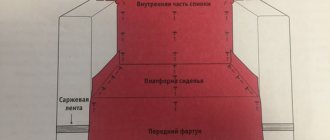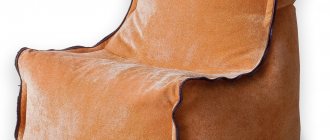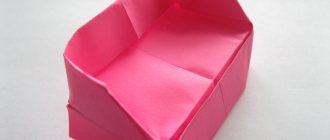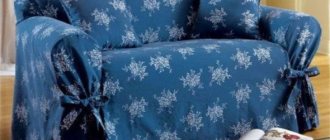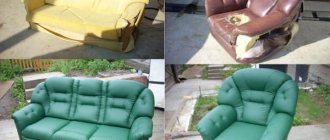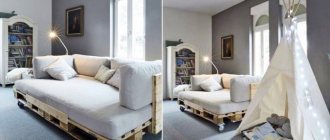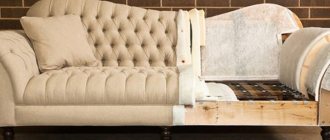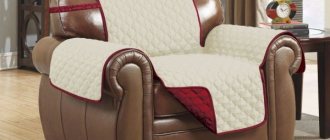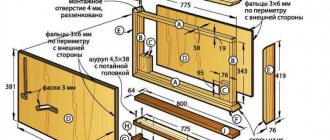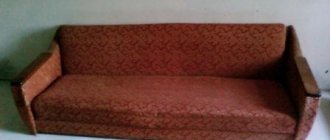Over time, an old sofa loses its attractiveness, or after another renovation it does not fit into the overall design of the room. You don't have to get rid of the furniture. You can sew a cover for a sofa in an easy way, which is quite simple; it will require a little time, fabric and a minimum of tools for work. Are there small children or pets in the house? The removable option is the most ideal. The cover is easily removed and washed. If the house has new furniture, a removable model will help protect the furniture, last a long time, and maintain its impeccable appearance. How to sew a sofa cover using an easy method is written in the article.
We sew a sofa cover with our own hands
A sofa cover is a useful and convenient element that will help breathe life into old furniture and preserve new ones, especially if the standard sofa upholstery is not entirely durable. By creating a cover you can change the design of your apartment, decorate the interior, and highlight individual details. In this case, there is no need to buy expensive materials and accessories or order a cover, spending a lot of money on it. You can easily make your own cover for an old kitchen, children's sofa, living room and bedroom furniture. This could be a cover for a leather or fabric sofa - it all depends on your tastes, preferences and what kind of furniture you prefer to use.
Advantages of a Euro sofa cover
The first reason for use is protection for both old and new furniture.
If there are small playful children and pets in the house, the additional coating will become a barrier and will absorb all animal hair, dirt, scratches and puffs.
In this case, you can also use a cover on a leather sofa to preserve the integrity of the expensive upholstery. From time to time it can be washed or dry-cleaned, and if it completely loses its aesthetic appearance, throw it away without regret and sew a new one.
The second reason is savings when updating. Even with the most careful use, there comes a time when you need to completely change the upholstery of your furniture. But this process is very expensive, and may also require transportation to a workshop and time.
When reupholstering, you will need to completely disassemble the structure and transformation mechanism of the sofa, which also does not help extend its service life.
Using a case is the most budget-friendly option, which guarantees no additional damage to the mechanism and filling of the product.
The third reason is aesthetic. Designer sofas are still quite an expensive piece of furniture. And when changing style, not everyone manages to purchase new sets.
Using a material with a new texture, color and pattern for covers can significantly change the design of the room. In addition, using one material for covering can make a set of completely different types of furniture into a single stylistic solution.
How to sew a sofa cover yourself?
In order to make a sofa cover yourself, all you need to do is apply the skills of working with thread and needle. A sewing machine will be an excellent assistant. But most of the work still needs to be done manually. Pattern making skills will also come in handy. After all, you need to make it yourself individually for your sofa.
But here too you can cheat. A very simple and easy way is to use an old cape that may have been lying around in the closet. It must be cut into separate pieces and transferred to new material.
An old cape is not found in every home. Fortunately, there are many master classes on the Internet that offer various methods and options on how to properly make a sofa cover. They provide step-by-step instructions that will simplify the creation of the pattern.
Step-by-step sewing instructions
Let's look at how you can sew a sofa cover with your own hands in step-by-step instructions. There are three manufacturing options:
- No pattern.
- We will reveal it locally.
- According to the pattern.
| Preparation method | Model features |
| Without pattern | An elasticated cover for a sofa can be made without a pattern. This will require a large amount of fabric, based on the following: the width is equal to five widths of the seat, and the length of the fabric is 3 times the length of the sofa. |
| Cut according to location | Sewing such a cover is simple and very profitable. It does not require a lot of fabric consumption and leaves little waste after work (about 20%). Suitable for standard shaped furniture only. This cutting option is used to sew a cover for a sofa without armrests (non-folding or folding book with mechanisms, accordion). |
| According to the pattern | It has undeniable advantages. The fabric area is fully utilized, the cover fits perfectly on the sofa, and is not only original, but also a unique product. |
Without pattern
Materials and tools
To sew a sofa deck, you need to prepare the following set of tools:
- Scissors. They must be sharp so that when cutting the fabric, creases do not form.
- Set of sewing needles. With their help, you can fix the details of a paper pattern on the fabric of the future cover. The more needles, the more comfortable the process of cutting out product elements.
- Sewing machine. In addition to the stationary one, it is also convenient to have a manual machine to work in weight.
- Yardstick. Needed to take measurements of the sofa.
- A simple pencil. Required for paper marking.
- Piece of chalk. Needed for marking the surface of the fabric.
Tools
Pattern of parts
To sew your own sofa covers, you need to make patterns. If the sofa has a simple rectangular shape or a corner model with a wall and back of a standard rectangular shape, then making it will not be difficult.
A pattern for sewing a sofa cover with your own hands requires accurate measurements of each detail. Measurements must be placed on graph paper, taking into account the direction of the split line. Then you should transfer the calculations performed to the material using chalk.
To make a pattern, you can use ordinary newspaper sheets. Carbon paper will also work. It is used to cover all the components of the sofa, outline their shape, and cut out the parts using scissors. They are all then assembled using tape. The resulting pattern is corrected right on the spot: the cuts are connected with tape, and the missing gaps are increased with new paper inserts.
After everything has been checked and joined, you should proceed to the stage of cutting on the material:
- The fabric must be ironed. Cotton and wool materials should be washed in warm water so that they shrink and the finished product does not decrease in size.
- Then the fabric should be folded with the right side inward. Pin the drawings using safety pins.
- Use chalk to outline the contours of the paper. Stepping back about 2 cm, draw a second line.
- Cut out the parts along the contour of the second line.
Pattern for a sofa cover
On a straight sofa
On the corner sofa
Sewing
The made pattern and step-by-step instructions for sewing a sofa cover require adherence to clear instructions. Sewing must begin with the basting stage. Sewing includes eight main steps:
- Sew the resulting parts using a running stitch.
- Try on furniture.
- Check that the parameters of the cover match the dimensions of the sofa.
- Sew the parts using a sewing machine.
- Finish the internal seams with an overlocker.
- Cut and sew the lining (if needed), and then sew it to the finished cover.
- Treat the fastener areas and edges of the product.
- If desired, decorate the case with decor.
Sewing a cover for a corner sofa with your own hands is not an easy task. There are two main manufacturing options:
- If a corner section is attached, then you need to sew 5 covers: for the main section, an extension, for the back and two armrests.
- If the corner section is insertable (or the sofa has a solid structure), then a simple pattern of a cover for a corner sofa is made separately for the “wings” and the corner of the furniture. Then all the parts are sewn together from the wrong side.
When stitching parts, it would be wise to use pleated fabric to disguise the joint (but only professionals can do this). It is much easier to choose the color of the material for the cover so that the seam is visually lost.
Sew with running stitch
Trying it on furniture
Sew down the details
We process the seams
Making a cover for a corner sofa with your own hands
The most difficult thing is to sew a cover for a corner sofa with your own hands. Before cutting, the fabric must be thoroughly washed, dried and ironed. This is done in order to provide for possible shrinkage of the product.
The cover must be created in separate parts. This cover can also be made for a classic sofa. It will appeal to people who value comfort and practicality. There are several options here:
- Attached corner section. You need to sew five covers with reinforced seams: for the main part of the sofa, the side part, the armrests and the back.
- Insertable corner section or solid corner structure. In this case, the covers are made separately for the corner of the sofa and for the wings and are sewn together from the wrong side. The most important thing here is to hide the seams between the corner and the wings. After all, they will be located on the seat and back. Pleated fabrics will help with this very well. But it's quite difficult to do. Factory pleated material is also quite difficult to work with. There is an alternative - choose a fabric with such a color that the seam on it is invisible.
Our advice: an easy way to hide a front seam. This can be done by introducing it with a fit on the tightening tissue. If you decide to sew a cover from a rough and dense material (for example, canvas in a rustic style), then all seams should be seams. They can be made using a sewing machine.
A variety of ideas for home crafts
There are a large number of technological techniques for home crafts that can make the interior not only more decorative, but also functional.
Even photocopying techniques are available for home crafts, allowing you to transfer designs onto fabric. The design is attached to the fabric requiring renewal with the front side. On the reverse side it is pressed with an ironing press or iron until the image is completely transferred. All that remains is to dry and iron the product.
Unusual vases are made from an ordinary beautifully shaped glass bottle. To do this, the outer surface of the bottle, in a spiral, needs to be tightly wrapped with decorative rope, fixing it with glue.
If you don’t want to bother with rope and glue, you can paint the bottles in bright colors, decorate them using the decoupage technique, or make an interesting painting on them.
Concrete, plaster and clay certainly provide room for creativity. These materials are used to make unique stucco elements for interior decoration. They are also used to create beautiful garden lamps, original vases, fancy candlesticks, exclusive figurines and other decor.
Such handicrafts can not only become an excellent decoration for your home interior, but also be useful in everyday life. For example, for safe movement around the local area at night, garden lights can be placed along paths and paths.
Homemade crafts are a fun activity. From the variety of ideas, it is easy to choose an option suitable for a specific interior in order to add a touch of individuality to it in the form of an original home-made product.
Try, experiment and you will definitely succeed.
What fabric to make a sofa cover from?
It is worth taking the choice of fabric seriously. Not every type of material will work the first time. In addition, the sofa cover should be practical and durable.
It is not recommended to use two extremes - upholstery fabric that is too heavy and dense, which is used to make upholstered furniture, and too light, does not hold its shape well and is thin, which requires additional processing.
Lightweight fabrics include chiffon, rayon and satin. Capes made from these fabrics look incredibly beautiful, but they will not last long and will quickly lose their attractive appearance. It is still better to use such materials for sewing clothes and accessories.
Many people believe that upholstery fabric will be an ideal option for sewing a cover, because it is used to create sofas, armchairs and corners. But pay attention to the fact that the upholstery is tightly fastened to the frame using a stapler and small nails. This suggests that such a material is completely inelastic. You simply physically cannot pull it over the back and armrests. In addition, do not forget that the cover must be periodically removed from the furniture in order to wash it.
That is why it is best to choose the golden mean - moderately dense, moderately soft and elastic material. Ideally, it should be impregnated with a special product. Waterproof material will allow the furniture to remain fresh and clean for a long time.
If you don’t want to specifically buy fabric to make a cover, you can use improvised materials. We present the options for what material the cape can be made from:
- made of eco-leather;
- from a blanket;
- from a bedspread;
- from jeans and many other things.
With a little effort and imagination, you can even make a beautiful sofa cover out of old clothes.
A sofa cover can be decorated in various ways. You can make ruffles at the bottom. Embroidery and ribbons will also look beautiful. A cape created in a patchwork style will look interesting. To create it you will need scraps of a wide variety of fabric.
Step-by-step master class
To sew a cover for a chair or sofa from thick, practical fabric, you first need to take measurements of the furniture.
Classic model
The easiest way is to cut out and sew a cover for classic sofas and armchairs that have strict rectangular shapes. If the armrests and back of the furniture are streamlined, the sewn cover will need to be supplemented with fixing ribbons, which can be tied with a bow or fastened with large decorative buttons made of natural wood.
If we return to the issue of cutting and sewing, then step by step this process will be carried out according to the following scheme:
Motanka doll: do-it-yourself toy and amulet
- The height, front width and length of the soft seats are measured without taking into account the lower part of the sofa (relevant when the design includes a frill), or together with it if the cover has a straight silhouette all the way to the floor.
- The dimensions of the armrests are measured (heights of the inner and outer side parts, width and thickness). The pattern for this part will have a rectangular shape, while the cover can be either straight or streamlined (depending on the configuration of the armrests).
- Measurements are taken from the back of the sofa. In this case, it is necessary to measure not only its outer and inner height, but also its width, minus the areas where the armrests adjoin.
- Based on the measurements taken, a paper pattern is constructed separately for each part, except for the armrests, since in this case one pattern and its mirror use for opposite sides will be enough.
- The resulting patterns are applied to the sofa to check the coincidence of the seams of the furniture and the paper edge (as well as the accuracy of the patterns).
- The finished patterns are pinned to the back of the fabric and outlined with soap or chalk, after which tolerances are made (the larger, the more reliable the seam will be).
- The products are cut, after which they are basted and stitched together on the wrong side in the same joints as for upholstered furniture.
- A frill is made separately and sewn to the already sewn cover around the entire perimeter.
At the final stage, a sketch of contrasting shades is pulled out from the finished covers, after which the first fitting or adjustment can be carried out, if necessary. The cape can be decorated with all kinds of decor, using twisted braid, heavy velvet tassels and other spectacular elements. It is worth noting that the described algorithm of actions is also useful for sewing a cover for a corner sofa with your own hands, which will have to be supplemented with a rotating element along the back.
Top 7 most unusual types of hand stitching
Round bed
Modern fashion requires the use of unusual furniture models in the interior. One of them is a round bed, which looks very bright and romantic. In order for a round-shaped bed to look impressive not only at night, but also during the day, it must be covered with a beautiful cover.
There are several interesting ideas that will help you cope with the task perfectly. These include:
- A classic case made of silk, velvet or tapestry fabric. To sew such a cover, two main patterns are used: with a frill and with a straight silhouette. In both cases, it is necessary to measure the diameter of the bed, its height and calculate the circumference. After this, using a needle and a pencil connected by a thread (not everyone has a giant teacher’s compass), a pattern of a round bed is constructed. The lower part of the cover is made separately according to the height and circumference dimensions.
- Fur cape. This option is rightfully considered the most luxurious, especially if real fur is used for tailoring. For example, fox skins make great round blankets if you sew them together, placing the faces in the center of the circle and the tails on the outer part. Lightweight, very warm and wear-resistant - you won't find a better bedspread. If the owners do not have such valuable raw materials available, you can opt for the recently popular faux fur in light shades. And it’s enough just to cut out a circle of the required diameter from a cut to get an impressive bedspread for a round bed or chair seat.
Making a sofa cover with an elastic band with your own hands
The elastic fastening is incredibly comfortable. It is used to make mattress covers and bed linen. This technology can also be used to create furniture covers.
Initially, you need to sew the cape itself. Then you need to sew a rubber band into its lower part. It will keep the cover in place in any situation, even when several people are sitting on the sofa.
Another advantage of this method is that the finished cape can not only be easily put on the sofa, but also removed from it. It is convenient for washing and cleaning.
In addition to the elastic, various other fasteners can be used. The cover with a lock is also incredibly convenient - it allows you to remove the cover from the sofa in just a few seconds. A simple universal tension cover is popularly called “Eurocover”. It can have many options that never cease to amaze.
We will reveal it locally
Cutting a sofa cover locally is technologically simpler than sewing a dress cover without a pattern, and developing patterns for the cover, and is also quite economical: up to 25% of the cutting area is wasted, depending on the thickness of the seat and backrest. This method is suitable for simple shaped sofas.
With the opening in place, the trace is sewn. sofa covers:
- Covers for geometrically simple, non-folding sofas without armrests, common in modern style interiors, and for book sofas, see below.
- Linings (case covers) made of technical fabric for dress covers sewn without a pattern, so as not to bother with the pattern of the cover case.
- Everyday saving covers (item 3 in the figure), incl. on the sofa in a formal cover.
How to sew a sofa cover with cutting in place is shown in pos. 1 and 2 pictures:
Sewing a sofa cover with cutting to place
Recommendations to reinforce the seams with wooden inserts are most likely either an unqualified translation of the original source, or simply an intuitive guess. In fact, using suitable pieces of wood, folds are formed to reinforce the seams with a turn, see above. If the pieces of wood are left in the seams, they will soon rub through both the cover and the upholstery of the sofa. At pos. 4 gives examples of how to decoratively decorate the covers of the wings of the cover on the armrests; Of course, your own solutions are also possible. If covers are required only for armrests, they are designed in a similar way; In this case, fabric waste is zero or almost zero.
About the role of the case cover
The undercover, firstly, improves the adhesion of the cover made of beautiful but slippery fabric to the sofa. In this case, it is sewn from thin cotton fabric, for example, linen. Old yellowed sheets are perfect; a slipcover made from them holds the satin cover on the faux leather sofa as if sewn on.
Another purpose of the cover is to protect the sofa itself from dirt and grease. If the sofa is leather, this is very important. In this case, the undercover is sewn in 3 layers: a fairly dense technical fabric (linen canvas, matting; you can use propylene from bags) is placed on the upholstery of the sofa, followed by a layer of padding polyester or, better yet, holofiber, and the cover holds the canvas, as in the previous one. case.
How to make a sofa cover with your own hands without sewing?
A furniture cover does not have to be made using sewing. There are other ways to create it. For example, a cover can be made from a single piece of fabric.
In addition, the cover can be knitted from threads. This can be done from scratch. Or you can use old sweaters for this. This decorative element will look very beautiful in a room designed in a rustic or Provence style. It will add comfort and warmth.
Trying to work without using sewing
This option is performed without stitching, simply using a large piece of suitable fabric. The cover is secured with wooden slats at the junction of the backrest and seat. This will give the product the necessary shape and will not allow it to move. Now you need to secure the fabric to the edges of the armrests with decorative clips, or simply manually hem it with a needle.
- When purchasing material, try to take two to three meters more than in the measurements. Even if the surplus is not needed for the main work, it can be used to make decorative pillows or pillowcases. Or use the leftovers to make frills and ruffles.
- You should not sew your first project from expensive fabric. It’s better to try on cheap material that you won’t mind throwing away if something goes wrong.
How to sew a corner on a sofa cover?
If you have purchased upholstered furniture with expensive and beautiful upholstery, it is clear that you do not want to hide it under various blankets and blankets. No wonder you spent hours choosing the shade of upholstery and texture that matches the pile of the carpet and the color of the curtains!
In such cases, you want to protect only the most sensitive and most dirty parts. You can easily make separate covers for the armrests, pillow, sides or seat. In addition, you can make compact pockets for remote controls, which is very practical and convenient.
If a common cover holds all the parts of the cover on the sofa, then the armrests can fly off very quickly. When creating them, it is necessary to consider an autonomous mount. Linens, elastic bands or ribbons, bows or laces are perfect. They will look beautiful. You can also use snaps or Velcro. But it is better to sew them on the bottom of the armrest so that they do not interfere. Otherwise, you will have to change them often or they will ruin your clothes.
This is very convenient, because you can make several capes at once. They're easy to change when you wash them, and they can also help refresh your sofa's design and make it more interesting when it starts to wear out. They can be matched to pillowcases, pillows or other elements of the room.
Materials
The stretch cover is made of cotton and elastane. Microfiber and polyester are also available. If the product is formed from loose fabric, then it is customary to say that it is a cover with a “skirt”. He will look attractive and even romantic. But the bedspread may have other options:
for chairs with headrest;
The choice of material for a chair cover is equally important both when sewing it yourself and when purchasing a finished product. Cotton is popular. It is easily breathable and completely environmentally safe. Cotton throws are recommended for use in children's rooms. They are often covered with various designs, and the colors are also quite numerous. However, you will have to purchase cotton capes for your home very often. This fabric is prone to abrasion and wears out quickly. Linen covers are denser than cotton ones and more beautiful. Linen absorbs moisture well and is soft to the touch. Jacquard or viscose are good alternatives.
Teak covers are quite popular. This is a combined (cotton-based) material. It is characterized by a “Christmas tree” pattern with a typical shine. Teak will practically not fade even in the strongest sun. This fabric does not fade when washed. And stretching during everyday use is unusual for it. Sometimes polyester is used. However, you can’t make a soft cape out of it. This is an elastic and easily stretchable material. But it is very durable. Therefore, it is suitable even for chairs in a children's room.
Velor is vaguely similar to velvet. But it is not difficult to distinguish these fabrics - velor has a shorter pile. And the cost of the material is noticeably lower. The material is not too fussy and it is easy to clean. Even those suffering from allergies of any kind can use a velor cape. Satin is widely used in the manufacture of quilted covers. This type of matter is different:
- density;
- smoothness;
- silky surface.
The satin has a glossy sheen. When using it, you can achieve increased aesthetics of the lining. For the manufacture of atlas the following is used:
viscose;
The tapestry is valued for its extraordinary harmony and external attractiveness. This fabric resists wear and tear and lasts a very long time. The tapestry is mechanically strong. It can be easily washed in a machine. There are many variations in tapestry design, which makes these wraps an excellent gift. Lovers of fleecy fabrics will definitely like plush chair covers. The fibers are not as thick as velvet
What is important is that plush products have excellent thermal insulation. This fabric is made from wool or cotton fibers
Fur (sheepskin and other similar materials) capes retain heat even better. They also absorb moisture more intensely than most other fabrics. Caring for sheepskin is easy. It will retain its attractive appearance for a long time. Covers made from this material help out in any weather; it is pleasant to sit on a fur cape even when the heating has already been turned off or has not yet been turned on.
An unusual variety are chenille capes. This material is strong and at the same time pleasant to the touch. For its production, completely special machines are used. Chenille is woven from fibers using a jacquard, satin or tapestry pattern
Important: the raw material for this fabric is always a mixture of dissimilar threads. Knitted products are often used
They are elegant and practical. Such capes immediately create the impression of closeness to childhood. Now such things are experiencing a renaissance, and they are being chosen, even made with their own hands, more and more often. A well knitted cover can last for several years.
Video
| Children's and playrooms | Environmentally friendly and pleasant materials are needed. Such fabrics should be easy to clean. Velor, chenille, microfiber, cotton are suitable. |
| Living room | Materials must be practical to use, resistant to external influences and easy to maintain. Optimal options: leather, eco-leather, jacquard, velor, microfiber. |
| Bedroom | Suitable fabrics are damage-resistant, non-fading and environmentally friendly. For example, flock, velor, chenille, microfiber. |
| Length | The distance from the point where the rear wall of the sofa touches the floor to the point where the front of the seat touches the floor. In other words, this is the height of the back of the back + the height of the front of the back + the depth of the sofa + the height of the seat. |
| Width | Distance from one armrest to another. |
| Armrest width | Distance from the point where the armrest meets the seat to the point where the armrest meets the floor |
| Armrest length | Distance between the edge of the armrest and the point where the armrest meets the backrest |
Decoration
You can decorate the finished product with bows, appliques or stripes. To decorate the armrests, a decorative rope with a diameter of 1 cm is best suited. Framing with a wide braid or ribbon will help to emphasize the lower part.
Covers for a sofa (chairs) can radically change the visual perception of furniture.
The isoprene layer plus dense pile allows you to avoid puffs.
